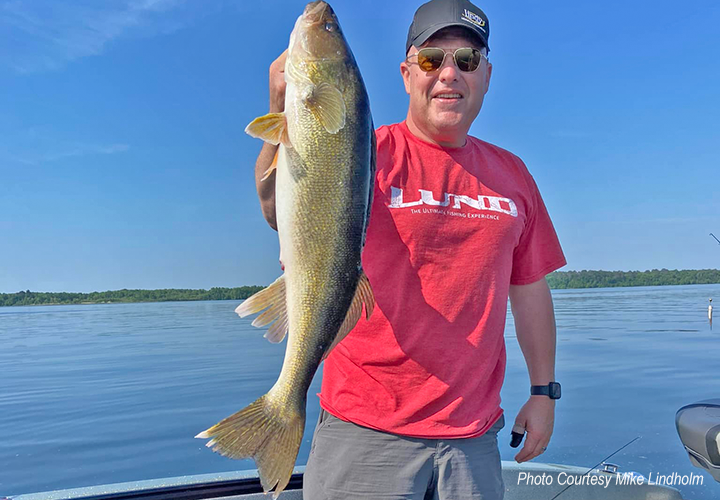Walleyes in both Lake Winnie and Cutfoot Sioux are in a seasonal transition. While some fish remain in relatively shallow water, 8 to 16 feet for example, others are migrating out to mid-lake structures. Instead of finding large, concentrated schools of fish, it’s more common now to find small schools of fish, in a wide variety of locations. So, exploration of fresh territory will pay off bigtime for anglers hoping to find a “hot bite”.
On Wednesday, anglers located good schools of fish in shallow water, not far from the resort. Fishing with jig and minnow combinations, they captured limits of keeper walleyes, and released a good number of larger fish too. At the same time, there were anglers fishing mid-lake structures and they found walleyes too. Whether you fish shallow or deeper depends on your fishing preferences.
Water temperatures have stabilized, and are solidly holding at about 71 degrees, varying by 1 or 2 degrees between day and night. Water clarity has begun to change, there is a slight-but-noticeable algae bloom taking hold in the big lake, somewhat stronger in Cutfoot Sioux. Insect hatches have been minimal to date, but indications of fish feeding on larvae have become more common this week. Some anglers also report viewing images of larvae on their electronics, and we could be on the verge of more widespread insect hatches.
One of our preferred guides, Reed Ylitalo also reported the discovery of large schools of tiny, ½ inch long perch. Identification was made initially on his graph, and confirmed when the tiny minnow sized fish were caught, snagged by the jigging lure he was using. The presence of freshly hatched minnows, along with potentially large-scale insect hatches means that walleyes are choosier about what and when they will feed.
The best bet for catching the fish in a positive feeding mood is to fish in the low light periods. Whether you prefer fishing late, or starting early, the odds of finding walleyes in the mood to eat are vastly improved. That’s not to say that walleyes won’t bite during the daytime, they will, we do know though that clear water makes it more challenging. The trick to catching them when the sun is shining is to avoid making direct contact with the fish, how you do that is debatable.
We don’t need to tell you that these days, horizontal sonar has become very popular, and is seen on the lake often. There’s no doubt that they are helpful, but don’t fall into the “hype trap” you do not have to use them to catch fish on Winnie.
Another local guide, Jeff Sundin argues this; “If the trick to catching walleyes in clear water is to avoid contacting the fish, then, by definition cruising the breakline, searching for them on any down image, side image or forward scanning sonar violates the principal. Seeing fish on the screen of your graph IS making direct contact with them. For me, creeping along the breakline, casting our lures out ahead of the boats travel path is almost as good. We may not “see” the fish coming, but they don’t see us coming either. So, when our lures drop into the water ahead of them, the element of surprise greatly improves the odds of triggering strikes good.”
No matter how you do it, everyone agrees that getting lures in front of fish before the boat passes overhead is important. Anglers insistent on using “old-school” presentations like Lindy Rigging, vertical jigging and bottom bouncing are at a disadvantage. These days, casting and retrieving jigs tipped with minnows, or soft plastics are effective.
Slip floats, increasingly popular on Winnie, are used to good effect right now too. Avoid fishing too close to the bottom, position your offering about 18 to 36 inches above the bottom, walleyes will come up willingly to grab a lively leech or fresh night crawler. If you love trolling spinners, consider learning how to use planer boards. They allow you to position your spinners out, and away from the boat instead of directly beneath it. The same tactic will help you position crankbaits and will likely come into play later this summer.
Northern pike in the eating size range are aggressive right now. People fishing for walleyes in Tamarack Bay are catching lots of them in their walleye presentations. Even folks fishing mid-lake structures are catching the occasional “bonus pike” as they pursue walleyes. If you’re interested in catching a larger pike, go with larger lures or use a slip float to present big, 8-to-10-inch sucker minnows. The old saw, “big fish, big bait” is especially true when seeking larger pike. We’ve heard that pike prefer forage that’s about 25% of their body length; this means that a 30-inch pike would likely want to eat baitfish in the 7-to-9-inch range.
Perch fishing has been spotty this week and anglers who find them report that they seldom remain in the same spots for very long. From reports at our fish cleaning station, deep water appears to be one key for catching them. Mid-lake structures adjacent to soft-bottom flats in the 25-to-30-foot range offer opportunity because of insect larvae. Gravel, light rock, and clam beds where crawfish populations are high will also attract perch.
Bass and panfish are active too, but like walleye, show a strong preference for feeding during low light periods. Right now, early risers have the advantage, especially when seeking crappies. A reliable pattern is to creep along the outside edges of vegetation. Casting and retrieving small jigs tipped with plastics into pockets and gaps in the cabbage will produce crappies for sure. As a bonus, you’ll catch some perch, walleye, pike, and bass along the way. If you like watching the sun, come up, we suggest doing it from the casting deck of your boat, you won’t be disappointed!



